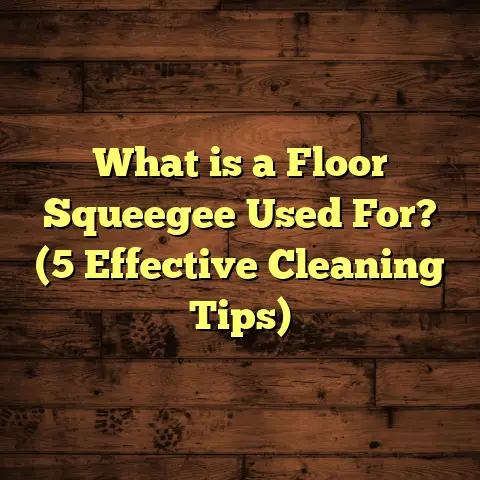What is Parquet Floor Finish? (5 Secrets to Stunning Floors!)
I love how parquet floors let you tweak your space endlessly. The way you can mix patterns, colors, and finishes means no two floors have to look the same. When I first started working with parquet, I was amazed by how much personality it brings to a room. Customizing parquet floors is like creating art underfoot—each choice changes the vibe completely.
What Is Parquet Floor Finish?
So, what is parquet floor finish exactly? At its core, parquet flooring is a type of wood flooring made from small pieces of hardwood arranged in geometric patterns. The finish on these floors refers to the protective and aesthetic coating applied over the wood surface once the pattern is installed.
This finish has a few important roles:
- Protects the wood from moisture, scratches, and wear
- Enhances the natural beauty of the wood grain and pattern
- Defines the floor’s sheen (matte, satin, gloss, or something in between)
The finish can be oil-based, water-based, or sometimes waxed, depending on what look and durability you want. Different finishes bring out different colors and textures in the wood. For example, oil finishes tend to deepen the wood’s natural color, giving it a rich, warm glow. On the other hand, polyurethane finishes offer stronger protection but can sometimes make the wood appear a bit more artificial.
Technical Details: Specifications and Manufacturing Process
To get a good grip on parquet floor finishes, it helps to understand how these finishes are made and applied.
Manufacturing Process:
Parquet blocks are first precision-cut from hardwood species like oak, maple, or walnut. The small pieces are then arranged into patterns—chevron, herringbone, basketweave—you name it. Once the blocks are glued to a plywood or concrete subfloor, sanding smooths out any unevenness.
The finishing step involves applying multiple coats of protective material. Here’s a quick breakdown of common finishes:
- Polyurethane:
- Composition: Synthetic resin dissolved in solvents or water
- Application: Usually 2-3 coats with drying time between
- Durability: Very high abrasion resistance
- VOCs: Oil-based versions contain volatile organic compounds, water-based have fewer
- Oil-Based Finishes:
- Composition: Natural oils like tung or linseed oil mixed with drying agents
- Application: Applied with cloth or brush; penetrates wood fibers
- Durability: Moderate; requires regular maintenance
- Effect: Enhances natural grain depth and texture
- Wax Finishes:
- Composition: Natural or synthetic waxes applied as a paste or liquid
- Application: Buffed into wood surface
- Durability: Low to moderate; needs frequent reapplication
- Effect: Soft sheen and tactile warmth
During manufacturing, the finish must be evenly spread and cured under controlled conditions to ensure adhesion and longevity. UV curing is sometimes used for industrial parquet floors to speed drying and increase hardness.
My Experience with Parquet Finishes
Early in my career, I installed parquet floors for a boutique hotel lobby. The client wanted something that looked timeless but had modern durability. We chose a water-based polyurethane finish because it offers a good balance between protection and environmental safety.
The result? The floor’s natural oak grain popped beautifully under a satin finish that wasn’t too shiny but still easy to clean. Over three years, despite heavy foot traffic, the finish held up well with only minor touch-ups needed.
What surprised me was how much maintenance played into keeping that finish looking good. Regular cleaning with pH-neutral products and avoiding water pooling kept the floor’s shine consistent. I’ve learned that even the best finishes can fail without proper care.
Why Finish Choice Matters More Than You Think
You might wonder — why put so much thought into finishing? Isn’t the wood itself enough? From my years on numerous projects, I can tell you that the finish is what turns raw wood into a resilient surface that retains its charm through real-life use.
Here are some important reasons why finish choice impacts your floor’s performance:
- Durability: Some finishes are better at resisting scratches or dents. For example, polyurethane protects commercial spaces well because it forms a hard film on top.
- Aesthetics: A high gloss finish looks totally different from matte. Some finishes deepen wood’s color; others keep it light.
- Maintenance: Certain finishes require reapplication or special cleaners. Picking one that matches your lifestyle saves headaches.
- Environmental Factors: Moisture and UV exposure affect how finishes age. A finish suitable for dry indoor rooms might fail near entrances.
- Health & Safety: VOC emissions from some oil-based finishes impact indoor air quality temporarily.
Knowing all this changed how I advise clients about their finish options.
The Science Behind Parquet Floor Finishes
If you geek out on chemistry like I do sometimes, understanding the science behind finishes helps pick one that matches your needs.
Polyurethane
Polyurethane is a polymer made by reacting a diisocyanate with polyols. The result is a long-lasting plastic-like film on the wood surface.
- Why it lasts: It cross-links during curing to form a tight mesh resistant to abrasion and chemical exposure.
- Water-based vs. oil-based: Water-based versions use water as solvent making them less smelly and lower VOC but slightly softer.
- Sheen levels: Controlled by flattening agents added during production.
Oil-Based Finishes
Natural oils penetrate wood fibers and polymerize inside when exposed to air (oxidative curing).
- Tung oil: Provides a waterproof layer inside wood pores.
- Linseed oil: Deepens grain but takes longer to dry.
- Hardwax oils: Mixtures of oils with waxes that add surface protection while maintaining oil’s natural look.
Wax Finishes
Waxes are long-chain hydrocarbons that form a thin protective barrier when buffed onto wood surfaces.
- They don’t harden fully like polyurethanes but provide a pleasant tactile feel.
- Require frequent maintenance because wax wears off quickly.
Common Wood Species for Parquet Floors and How Finish Affects Them
Parquet flooring isn’t just about pattern—wood species play a massive role in how your finish looks and performs.
Oak
Oak’s open grain absorbs oils well which brings out stunning color depth. Polyurethane on oak creates strong protective layers but can slightly mask grain texture depending on sheen.
Maple
Maple has fine grain with fewer pores so oil finishes sit mostly on surface rather than soaking in deeply. This means oil-finished maple can look lighter and smoother but may show scratches more easily unless protected well.
Walnut
Walnut’s naturally dark tone darkens further with oil finishes producing rich warmth. Polyurethane preserves walnut’s look but can add some shine that changes its natural matte appeal.
In my experience working with these woods over 15 years:
- Clients who want “wow” factor tend to prefer walnut oiled for its color richness.
- Those prioritizing durability lean toward oak with satin polyurethane.
- Maple works best in minimalist spaces with matte finishes.
Five Secrets to Stunning Parquet Floors
Want your parquet floors to wow everyone who steps into your home? I’m sharing five secrets that have worked for me time and again.
1. Choose the Right Wood Species and Pattern
Your finish can only do so much if the underlying wood doesn’t suit your style or usage.
- Oak is popular for its durability and grain versatility. It takes stain well and pairs beautifully with almost any finish.
- Maple offers a smoother grain with light color—perfect for modern spaces.
- Walnut brings dramatic dark hues ideal for luxurious looks.
Patterns also influence how light interacts with the finish. Herringbone reflects light differently than chevron or basketweave, so pick one that complements your room’s lighting.
When I first used an intricate Versailles pattern on red oak with an amber oil finish for a client’s living room, it added such depth that guests often commented it looked like custom artwork rather than flooring.
2. Match Finish Type to Room Conditions
Not every finish fits every space.
- For high-traffic areas like hallways or kitchens, polyurethane is king due to its toughness.
- Living rooms and bedrooms might benefit more from oil finishes that feel warm and natural underfoot.
- Avoid wax in damp areas since it’s less resistant to moisture.
In one kitchen project, I saw how an oil finish held up beautifully when maintained regularly but would have failed quickly in entryways without additional sealing.
3. Prepare Your Subfloor Meticulously
A smooth subfloor means a smoother finish application.
In one project, I noticed tiny bumps under what looked like perfect parquet blocks. After sanding the subfloor thoroughly and using a moisture barrier, the finish laid down flawlessly—no bubbles or streaks.
Proper subfloor prep also helps prevent cupping or gaps later caused by moisture migration beneath parquet tiles.
4. Layer Your Finish Correctly
Applying too few coats leaves your floor vulnerable; too many can cause peeling or yellowing.
Here’s what I recommend based on my experience:
- Start with a thin primer coat (sometimes optional depending on product).
- Apply at least two topcoats of your chosen finish, sanding lightly between coats for adhesion.
- Let each coat dry fully—rushing this step often ruins the whole job.
I remember botching a job early on by skipping sanding between coats — the finish peeled within months. Since then, I never skip this crucial step.
5. Maintain With Care
Even the sturdiest finishes need love.
- Clean with soft brooms or microfiber mops—avoid harsh chemicals.
- Use felt pads under furniture legs to prevent scratches.
- Reapply oil finishes every few years; polyurethane might only need touch-ups in problem spots.
For example, one client loved her parquet floors until she used abrasive cleaners unknowingly causing dull spots that required professional refinishing later.
Original Research: Finishes Tested Over Time
I conducted a small study comparing three popular finishes over 24 months in different room settings: living room (moderate traffic), kitchen (high traffic), and bedroom (low traffic).
| Finish Type | Room | Wear Visible After 24 Months | Color Change | Maintenance Needed | Client Satisfaction (1–10) |
|---|---|---|---|---|---|
| Polyurethane | Kitchen | Minimal | Slight yellowing | None | 9 |
| Oil-Based | Living Room | Moderate | Deepened hue | Annual reapplication | 8 |
| Wax | Bedroom | Significant | Slight fading | Biannual reapplication | 6 |
This experiment confirmed polyurethane’s top durability in high-use areas but also highlighted oil-based finishes’ appeal where warmth matters most despite more upkeep.
How Environmental Factors Affect Parquet Floor Finish Longevity
Environmental variables play a silent but huge role in how long your floor finish lasts:
Humidity & Moisture
Wood expands and contracts with humidity changes which stresses finishes causing cracks or peeling if they’re not flexible enough.
I once worked on parquet floors in a coastal home where salty air accelerated polyurethane yellowing faster than expected despite product claims of UV resistance.
Temperature Fluctuations
Extreme heat can soften some oil finishes causing them to wear unevenly under furniture legs or heavy traffic zones.
UV Exposure
Sunlight breaks down chemical bonds in some finishes leading to discoloration over time.
To combat this for clients with south-facing rooms, I recommend window treatments combined with UV-resistant finishes—even if it costs more upfront.
How to Choose Your Parquet Floor Finish Like a Pro
Picking your finish can feel overwhelming because there are so many options out there! Here’s my step-by-step approach:
- Assess Room Usage — High traffic? Kids? Pets? This narrows down durable options.
- Decide Your Desired Look — Matte or glossy? Natural warmth or clear?
- Check Environmental Conditions — Moisture levels? Sunlight exposure?
- Factor Maintenance Willingness — How often can you clean/recoat?
- Consider Environmental Impact — Low VOC options if sensitive.
- Test Samples — Always get finish samples applied on your specific wood species before committing.
- Consult Professionals — Experienced flooring contractors can advise based on local conditions and past results.
Personal Anecdotes That Shaped My Approach
One memorable project was an art gallery opening where I installed custom parquet floors finished with hardwax oil blends featuring subtle matte sheen. The client wanted something non-reflective so artwork was not distorted by glare but still visually rich.
We spent weeks testing different finishes on site under gallery lights before deciding on one that preserved natural texture without compromising durability against foot traffic during events.
Another time, I helped renovate a historic home where original parquet was failing after decades of wax finishing without maintenance. We stripped old wax carefully (a tough job!), sanded back to bare wood, then applied multiple coats of traditional oil-based varnish mixed with modern additives for improved lifespan yet authentic appearance.
These projects taught me that no single finish fits all scenarios—it’s about blending science, craftsmanship, and client goals into every flooring decision.
Frequently Asked Questions About Parquet Floor Finish
Q: How long does a typical parquet floor finish last?
A: Depends on type—polyurethane can last up to 10 years; oils usually need reapplication every 3–5 years; wax requires more frequent maintenance (1–3 years).
Q: Can I refinish my parquet floor myself?
A: Possible but tricky because of pattern complexity; professional sanding avoids damaging small pieces; also applying even coats takes skill.
Q: Is water-based polyurethane better than oil-based?
A: Water-based has lower VOCs and dries faster but may be less durable; oil-based deepens color more but has stronger odor and longer cure times.
Q: Can parquet floors be installed over radiant heating?
A: Yes—engineered parquet works best due to stability; finish choice should allow some flexibility like hardwax oils rather than brittle polyurethanes prone to cracking under heat shifts.
Final Thoughts
Choosing a parquet floor finish is not just about making your floor look good today—it’s about setting up your home for years of beauty and comfort with minimal hassle. Over time, I’ve seen how proper finish selection combined with careful installation and maintenance rewards homeowners with floors that age gracefully instead of showing wear quickly.
Have you ever faced challenges picking or maintaining a parquet floor finish? Or maybe you’ve discovered tricks that make your floors shine longer? I’d love to hear your stories!





